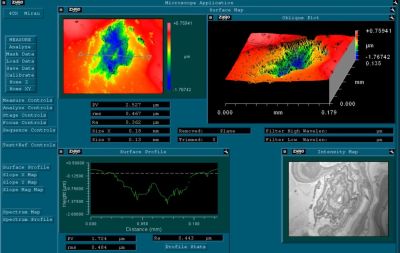
White light interferometry (WLI) is a contact-free optical method for measuring surface height. It uses the phase difference between the light reflected off a reference mirror and the target sample to calculate the height profile of the sample’s surface. As complex as this sounds, it doesn’t take expensive hardware to build a WLI microscope, as [Huygen Optics] explains in a detailed introductory video on the topic. At its core you need a source of white light (e.g. a white LED), with a way to focus the light so as to get a spatially coherent light source, like aluminium foil with a pin hole and a lens.
This light source then targets a beam splitter, which splits the light into one beam that targets the sample, and one that targets the reference mirror. When both beams are reflected and return to the beam splitter, part of the reflected light from either side ends up at the camera, which captures the result of the reference and sample beams after their interference (i.e. combination of the amplitudes). This creates a Michelson interferometer, which is simple, but quite low resolution. For the demonstrated Zygo Newview 100 WLI microscope this is the first objective used, followed by a more recent innovation: the Mirau interferometer, which integrates the reference mirror in such a manner that much higher resolutions are possible, down to a few µm.
This is not the be-all of interferometry, of course, with the field being much larger than just these two interferometer types. It is however a great demonstration of how simple and effective this type of microscope is, with its use common in many scientific experiments. The Michelson interferometer dates back to the 19th century, and more recently the largest Michelson interferometer in existence today over at LIGO (laser interferometer gravitational-wave observatory) has been used to detect the presence of gravitational waves based on the slight difference between the two reflected beams of spatially coherent light.

















Stay away from the white light!
Using infra red instead of visible light, an interferometer can also be used to identify molecules: https://en.m.wikipedia.org/wiki/Fourier-transform_infrared_spectroscopy
An offshoot of interferometry, called the Lyot test (I think), has been used to test optics. If memory serves, a phase shift is introduced in part of the beam. The test highlights changes in slope of the optical surface. What I *do* recall: according to Texereau’s “How to Make a Telescope”, the Lyot test can visualize imperfections of the surface in question that are about one angstrom high(!!). Note, this is the average height of a relatively wide defect.